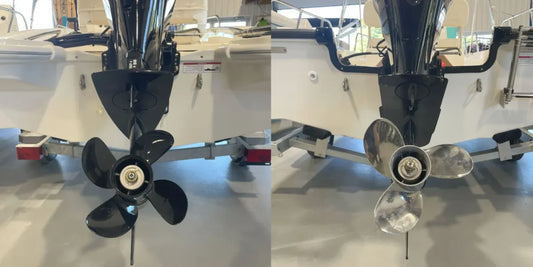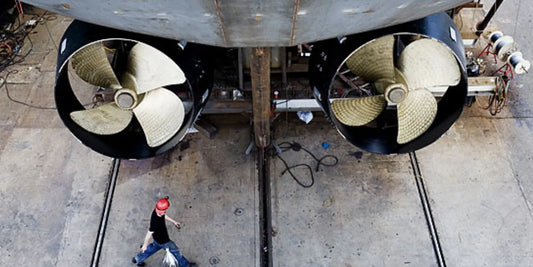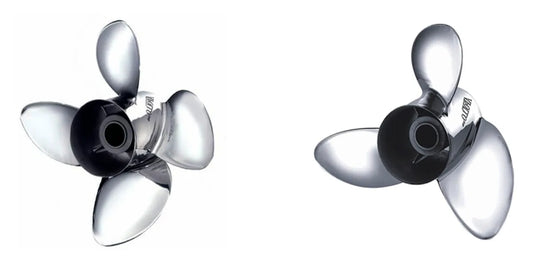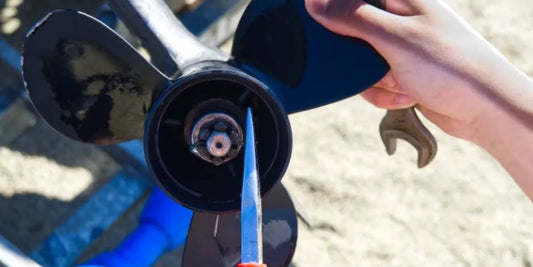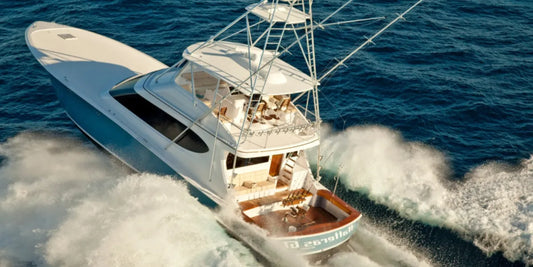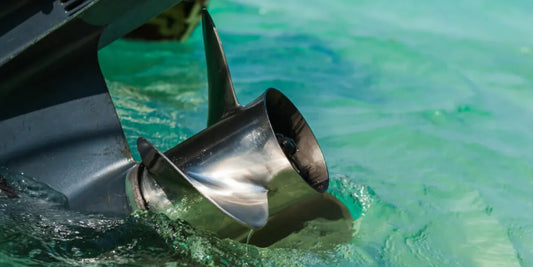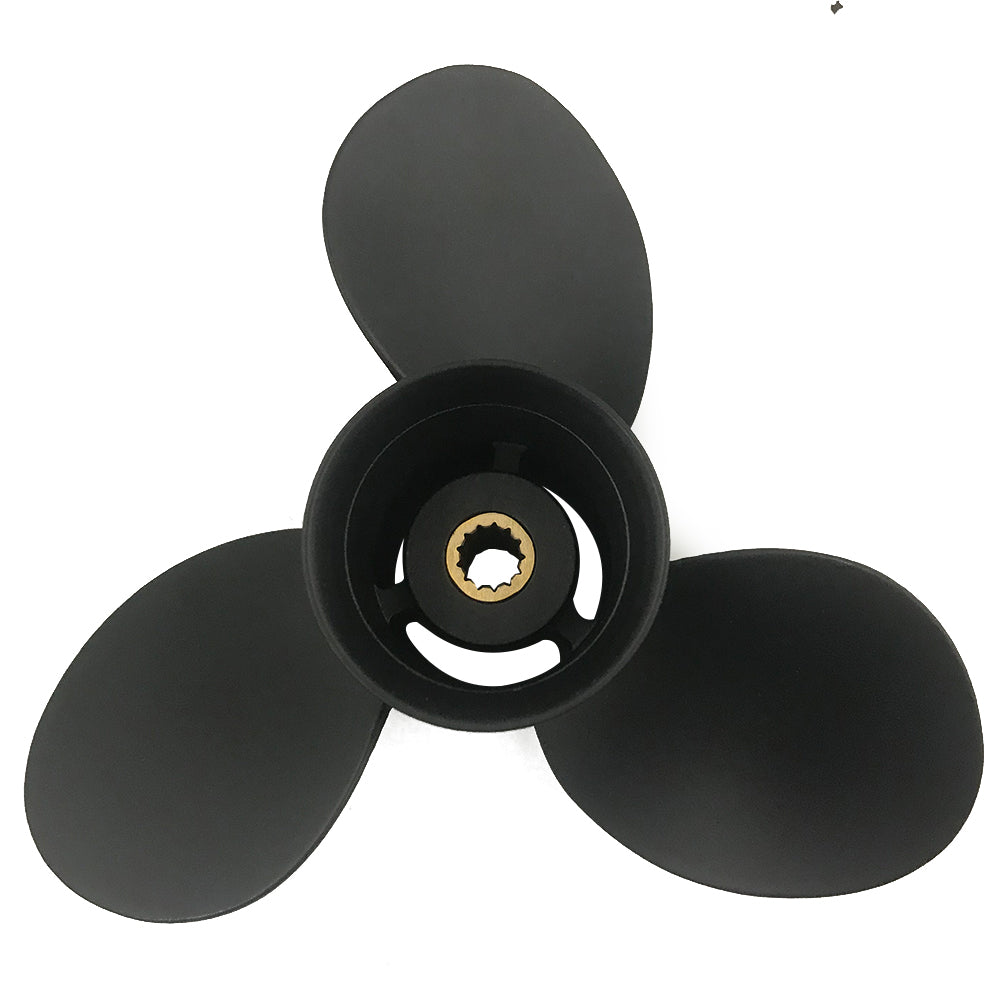The correct selection of a boat propeller should not be underestimated when desiring to utilize the performance and fuel economy of the vessel positively. Whether a person is an experienced or an inexperienced sailor, knowing how to choose the best propeller is essential when making a more pleasant and cheaper trip. This text will teach you the essentials from the most complicated, such as pitch and diameter, to the simple, such as the material being used; it will help you ensure that your boat performs at its peak. Further, we shall look at how the right propeller will enhance the experience of being on a boat and cut the time and money spent on the water.
Understanding the Types of Boat Propellers

Outboard Propellers: Features and Benefits
Outboard propellers are specially designed for engines placed outside of the body of a boat, which is a convenient and accommodating option for various ships. They are generally made out of materials such as aluminium and even differently saving steel, all of which have their advantages in terms of application. While the former are lighter, more cost-efficient, and well-equipped for casual situations, the latter type is favored for its toughness, especially considering that the performance is always in ‘worst-case’ scenario conditions.
Trends observed in the outboard propellers include enhancement in the solutions for specific requirements among outboard propellers, including single-blade or design configurations. These changes significantly affect the boat's speed and fuel efficiency as the handling of the propeller directly influences them. Furthermore, for boat motor enthusiasts, fewer dorks have aided them in increasing their boat’s speed; hence, their size or design is called a performance propeller, whereas more dense performance ones are convenient in possibly choppier waters. These changes significantly affect the boat's speed and fuel efficiency as the handling of the propeller directly influences them.
In addition, the blade angle and diameter of the propeller also play a significant role in the propeller's performance, concerning acceleration and performance limits requirements for individual engines and boat modes. The main new developments in outboards also tend to revise the old concepts, incorporating variable pitch forms and protective, durable coatings that are the best fit and effective maintenance even in the highly corrosive marine environment. They could also include the most relevant enhancements by applying various materials, or specific size or shape designs, keeping the environmental impact in mind for these products.
Recent advancements in outboard propeller technology also incorporate innovations like variable pitch designs and specialized coatings, enhancing both their longevity and adaptability to diverse marine environments. By carefully selecting the right combination of material, size, and design, boaters can achieve this dream.
Aluminum Propellers: Pros and Cons
Aluminum propellers are a favorite among recreational boaters, primarily because of their affordability and versatility. These propellers present one of the major advantages of aluminum, which is their lightweight nature. They lessen the load on the engine and thereby contribute to fuel efficiency. Repairs can also be done without much hassle since aluminum propellers can often be straightened out in cases of dents and bends created by accidental impacts.
The negatives, however, are the reduced durability of aluminum propellers compared to their stainless steel counterparts. Being a softer material, aluminum propellers are quite often damaged by debris or sand in shallow waters. Furthermore, aluminum propellers usually do not work well in high-speed and heavy-load conditions, thereby becoming unsuitable for high-power and large vessels. Nevertheless, in the context of their limitations, the aluminum propeller affords a very affordable and all-purpose solution for most boaters.
Sharrow Props: Innovative Design Advantages
The Sharrow style has revolutionized the marine industry with its innovative design and high-performance ability. Sharrow props have an unusual looped blade design, in contrast to traditional propellers, that enhances energy efficiency by reducing cavitation and drag. This design permits a smoother water flow, using less fuel while eventually causing less wear on the engine.
Research and studies show that Sharrow props can save 9-15% on fuel under average operating conditions, making them a greener and cheaper choice. They also provide quieter running conditions and smoother handling, which substantially augment the seagoing experience. Furthermore, the engineering of these Sharrow props allows increased thrust at lower speeds, granting benefits when performing precise movements and dockings. Hence, this entails the breakthrough technology for achieving performance and sustainability shifts among recreational and commercial marine industries.
Factors Influencing Boat Propeller Selection

Assessing Your Boat's Specifications
Two sets of major laws are under consideration regarding a boat's specs to be analyzed for the right propeller. One primary consideration is the size and weight of a ship. Heavier boats require a larger diameter propeller to generate enough thrust; lighter boats, conversely, favor a smaller, more performance-oriented prop. The type of boat also matters-racing, fishing, and pontoon boats all have specialized demands of both the performance and operational sort. For example, a speedboat might want all of its attention on top-end speed and acceleration, whereas, in contrast, a pontoon boat is more into smooth cruising and good performance at low speed. Next, appreciating what your boat is designed for is vital to making an educated choice.
Another essential consideration would be the strengths and gear ratios of your engine. These ultimately define the pitch of the prop. Pitch describes how far the propeller moves the boat forward through the water for one revolution. A high-pitch prop is suitable for higher speeds and may also not be efficient with an underpowered engine. A low-pitch prop will give better acceleration and is useful when towing or moving through water with a heavy load. Matching your engine with the right propeller pitch will provide top speed, fuel economy, and overall performance to fit your boating lifestyle. Other considerations would include how the boat would be used, the prevailing water conditions, fuel economy, and other things, as well, to culminate in a broader evaluation.
Importance of Fuel Efficiency in Prop Selection
Fuel efficiency is instrumental in selecting the right boat propeller since it also impacts the cost of operation and environmental sustainability. A correctly chosen propeller allows the engine to run within the RPM range. It was designed to work efficiently, minimizing fuel consumption while giving maximum performance. Improper sizing or pitching of the propeller would load that engine, tasking it to massive fuel consumption, besides mechanical breakdowns and higher emissions. For those operating long distances or spending long hours on the water, even an incremental increment in fuel efficiency translates into significant cost savings over time.
At the core of fuel-efficient prop selection is balancing power delivery and resistance. Pitch, diameter, and number of blades determine how your propeller impacts your boat's movement through water. For instance, high-pitch propellers could generate higher top-end speeds but appear a little fluid efficient at low speeds. In contrast, low-pitch propellers produce a fine thrust at low speeds, thereby improving fuel efficiency-governed walking in slow or harsh conditions where lift equals drag, either operation or enticing.
Advanced materials and engineering are also employed in state-of-the-art propeller designs to improve fuel efficiency. Stainless steel propellers are generally more efficient than aluminum ones because they have thinner and more rigid blades, thus reducing drag and increasing overall efficiency. Variable pitch propellers and modern computer modeling have further improved how boats counter forces of propulsion to ensure that engines work at optimum efficiency. Besides such technological considerations, if your propeller complements your ship's performance and fuel consumption requirements, the engine will remain healthier for a longer time and result in a subdued carbon footprint.
Choosing the Best Prop for Your Needs
Buying a propeller should be based on many factors that fit your needs, such as the material used, diameter, pitch, and number of blades. Aluminum props are preferred for economy and durability, whereas stainless steel props are best for performance and resisting distortion in high-speed-load situations. Propeller diameter and pitch affect a boat's performance. Higher-pitch propellers will give greater top speed, while a lower pitch enhances acceleration and towing ability.
In addition, the number of blades significantly affects the performance of a propeller; since three blades are standard for high speeds and better efficiency, four or five blades offer a more comfortable ride and greater thrust at low speeds. Moreover, the new cupped blade and progressive pitch increase control and reduce slippage. Matching these features with your boating activities of fishing, water sports, or cruising will give better fuel efficiency, handling, and performance on the water. Always rely on a trusted propeller guide and consult with professionals before the final choice.
Performance Considerations When Choosing a Propeller

Impact of Propeller Size on Boat Performance
Since propeller size plays a vital role in determining the boat's speed, fuel economy, and handling, the measurement of propeller size considers diameter and pitch. A larger diameter means more water can be pushed, which is helpful for heavier boats or towing, but will reduce the top-end speed of the hull. Smaller diameters generate less drag, thus enabling the ship to attain higher speeds if it is light enough. Pitch, which is the distance moved by the propeller in one rotation, complements the diameter in determining the characteristics of the propeller. A higher pitch increases speed at the cost of lower acceleration, while the opposite can be said for a lower pitch.
One revolution of the propeller is equal to the distance it will move through the water if it pitches at that distance. Changing the pitch by an inch results in a visible difference in RPMs, which will generally vary around 150 to 250 RPMs for every inch shift in pitch. Either way or another, the propeller must help the engine operate within its optimum RPM range, or either too high or too low will result in engine damage and inefficiency. Parameters of propeller size that you consider about the boat's weight, use, and engine specifications go a long way in assisting a good compromise between performance and fuel efficiency.
Blade Pitch and Its Role in Performance
Blade pitch is an angle or twist given to a propeller blade, which directly affects the speed and performance of a boat. A propeller with a large pitch moves the boat farther with every propeller rotation and is, therefore, suitable for high-speed maneuvers. Lower pitch propellers generate higher thrust and acceleration and are used for towing and heavy loads. Generally speaking, pitch and RPM have an inversely proportional relationship; that is, on raising one, the other falls.
For instance, a 19-inch pitch propeller would keep cruising speed efficiency for the boat at a lower RPM. In contrast, the 17-inch pitch propeller would give more acceleration but a higher "operational" RPM range. Blade geometry, blade number, and material choice also contribute to performance. Proper pitch design, in conjunction with all these parameters, allows the boater to enhance handling, fuel economy, and smoothness of the ride per his requirements. The pitch should be calibrated accurately according to engine specifications and application so that the vessel performs efficiently under varied conditions.
Testing Different Props for Optimal Results
Suppose you've ever had the chance to test a variety of propellers out on the water. In that case, you will know that an extensive set of variables must be considered in deciding which one will best fit your vessel and use. Evaluating how the prop affects speed, acceleration, and fuel consumption is crucial, as these factors correlate with maximum performance. It is also essential to test in varied conditions, such as having different loads onboard, since weight significantly alters how the boat feels and how much the engine is strained. Thereafter, look at parameters such as pitch, diameter, number of blades, and the like that directly affect their performance under different operating conditions.
With technological advances, testing can be done with the exact speed and fuel consumption of the engine being recorded by GPS and onboard monitoring systems. With a good data set, the boater compares the results and picks the most suitable propeller. The regular tests provide for any changes that might have occurred, that is, wear and tear, changes in environmental conditions of boating, and weight of the cargo, thus guaranteeing long-term efficiency and satisfaction.
Maintenance Tips for Prolonging the Life of Your Boat Propeller

Regular Inspections and Cleaning
Regular boat propeller inspection and cleaning represent critical activities to extend their lifespan and maintain good performance conditions. Any nicks, dents, or bends can obstruct efficiency and place unnecessary stress on the engine. Look out along the edges and blades for any slight malformations that might hamper the entire balance of the propeller. Propellers also need to be checked for corrosion or cracking in the hub area, for any overt operational failure can result if such issues are not attended to promptly. Dirtying becomes a little more complex once you add in corrosion. Regular inspections will enable boaters to spot little problems on time, before the repairs become severe and expensive.
After inspection, attention is to be paid to cleaning the propeller. Foreign debris such as seaweed, barnacles, and fishing lines appears slowly with time, draining efficiency. Use a soft brush with mild detergent to clean the propeller of dirt and growth. In cases where the buildup is excessive, giving the propeller a good soak in a vinegar solution or applying a reinforced, clean marine-grade cleaning product will soften the debris without damaging the material. Following the cleaning, allow the propeller to dry thoroughly to avoid rust or corrosion, especially if stainless steel or any other corrosion-prone alloy materials are used in its construction. Building this into your lifestyle will double the boat's good working conditions and the time you can enjoy the big investment.
Common Issues and How to Fix Them
Some of the many common propeller issues may degrade performance and efficiency, depending on the nature of specific problems. Consider the following issues and their solutions:
Propeller Damage: Dents, cracks, and bent blades may be experienced by the propeller from striking underwater objects or debris. Vibration might thus arise, and loss of efficiency and speed may follow. Hence, whenever the propeller is used, inspection should be done to ensure there is no visible damage, and if there is, it should be repaired or replaced by a professional. Having a spare propeller onboard is also an ideal option to avoid delay in the case of an emergency.
Cavitation: This is when air bubbles form around the propellers, thereby reducing the propulsion of the boat and maybe causing damage to the propellers with time. This usually occurs due to the wrong size or shape of the propeller, the speed of the cruise being too high, or an obstruction near the blades. To avoid this, make sure that the size of the propeller you have is best suited for your boat; also, take care not to overload the ship because that may affect the balancing.
Corrosion: Metal propellers are prone to corrosion, especially in saltwater. This corrosion causes the propellers to weaken and lose performance over time. To protect against corrosion, use sacrificial anodes, apply anti-corrosion coatings as necessary, and rinse the propeller with fresh water after each use in saltwater.
Imbalanced Propeller: If unbalanced, the propeller can produce vibrations and noise, which leads to engine wear and uncomfortable boating conditions. Imbalance can be caused by uneven wear or the buildup of marine organisms on the blades. Cleaning the propeller and repairing any dents or damage can restore its balance and enhance its performance.
Decreased Thrust: Marine growth, such as barnacles and algae, tends to build up on the propeller over time, thereby decreasing thrust and efficiency. Washing the propeller surfaces from time to time with non-abrasive tools would go a long way. Single-side anti-fouling coatings also greatly help reduce the growth of marine life.
Recognizing these common problems and taking measures to treat them helps maintain propellers' service lives and ensures smooth and effective operation on water.
When to Replace Your Propeller
Knowing when to replace a boat's propeller is vital to ensure optimal performance and prevent future costly repairs. One major indicator of the need for a replacement is the sight of visible damage, like cracks, bends, or corrosion on the blades of a propeller. Such flaws cause an imbalance and diminish the efficiency of the propulsion mechanism.
Another indicator is loss of performance, such as a reduction in boat speed, a rise in fuel consumption, or difficulty attaining the usual top-end RPM of the boat. All of these have been described as owing to wear from a propeller that no longer performs to its design. More frequent vibrations, emanating at irregular intervals, or strange noises could also indicate an injured or unbalanced prop.
The matter of materials should be taken into account, and the age of a propeller can be an important consideration. Being cheap, aluminum is not as good with regard to wear and tear as stainless steel. Anywhere wear would be, no matter how minimal, can accumulate and eventually require replacement. If the boats will be engaged in high-speed applications or towing for water skiing or wakeboarding, then a performance-cut prop is fairly likely to make a noticeable improvement.
By assessing all these factors and inspections, the owner can ascertain when to replace their prop to ensure a clean look for efficient and smooth boating experiences.
Expert Recommendations for Propeller Selection

Consulting Professionals for Best Practices
When it comes to propeller selection for my boating activity, I consider it critically important to consult with professionals. Their knowledge helps me sort through the numerous propeller designs, materials, and performance characteristics that may suit my particular kind of boat and intended use. During consultations, I give as much detail as possible about my boat's size, engine specs, and how I plan to use it, whether for casual cruising, towing a water sport, or fishing, so they can make recommendations that fit my needs.
Having professionals by my side also informs me about the most recent trends and advances in propeller manufacture, including those designs that enhance fuel efficiency or speed. Practical advice also pours from the mouths of the experts, such as how to maintain a propeller properly so that it lasts longer and performs better. They help me with pros and cons depending on materials such as aluminum or stainless steel, basically on my expectations of budget and performance. So through this cooperation, I can genuinely rely on informed choices for better boating experiences.
I usually rely on certified propeller specialists or go straight to the manufacturers to get the best advice. Many experts know how to balance the tuning requirements for the best propulsion. The tips of these specialists will spare me time and money in the long run and ensure that my boating experiences are safe, efficient, and enjoyable. Therefore, engaging with knowledgeable professionals has become vital to my prop selection process.
Online Resources and Tools for Prop Selection
When I used to peruse online materials and tools for prop selection, I heavily relied on manufacturer websites as a basic reference. Many of the world's top brands have manuals, calculators, and product specifications. These tools allow the user to plug in information about their boat, such as dimensions, weight, engine type, and the purpose for which it is used, to get a list of properly matched prop options. The same set of websites often also has user manuals and FAQs that answer those questions that may bother me during the product selection.
In addition to manufacturer websites, I frequently rely on boating forums and communities that share knowledge among experienced practitioners. These platforms are beneficial because they provide real-world experiences and feedback from people who have tested specific props in different conditions. I also watch video tutorials and walkthroughs on HowTube that discuss prop types and their performance attributes in a rather visual and practical way. This corroboration of technical information and practical advice makes for an efficient and informed selection process.
For more technical comparison, I occasionally look into online marketplaces specializing in marine equipment. These sites have user review sections and rankings, giving me some idea of how a specific prop performs in different real-life scenarios. All these third-dimensional online resources have guided my bid and factual experiences and helped me select the right prop for my boat.
Customer Reviews: Learning from Others' Experiences
In terms of customer reviews, I would say they are instrumental in differentiating a product based on performance under different conditions. Hearing from other boaters about their experience with specific propellers is very helpful. This gives a clearer picture of the pros and cons of a particular model. They talk about claims such as better fuel consumption, smoother boat rides, or any difficulties they faced, and these are often things I had not considered before. I try to ensure I am searching for reviews by people who use their boats in the same conditions as mine to determine whether that prop would satisfy my needs.
Another thing I look for is commonality among reviews. If a few reviews mention a lack of durability or performance issues, that could raise red flags for me. Positive comments always lift my expectation for something to be said to be good, and compliments surrounding product longevity or versatility are good signs that I have found the right product. I like reviews about customer support because it matters how well an engineer supports their products in case issues arise after purchase. This little bit of feedback from other boaters makes the difference in cementing my decision and gives me confidence when choosing the right prop.
Reference Sources
- MIT: Marine Propellers
- Worcester Polytechnic Institute: Analysis of Marine Propulsion
- Maryland Department of Natural Resources: Propeller Safety
Frequently Asked Questions (FAQs):
What is the impact of propeller pitch on top speed?
A propellant is a player who plays a crucial role in determining a boat's top speed and overall performance. A propeller with the highest pitch, like a 21-pitch propeller, is created to move the ship forward at very high speeds, which is very good for cruising. But when this is done, turning ability and the time taken to have the boat on a plane gladly nears three and a half hours as it wastes both torque and hole shots with seconds. In contrast to a higher pitch, which usually optimizes boat speed only, ceteris paribus, it is not good for economy and instant acceleration because it will be associated with a lower pitch propulsive system. It is essential to find the most suitable propeller for your boat. After all, all boats come with specific propellers where the propeller is rated for a certain engine horsepower. Remember to always look at the RPM range for correct performance.
What Makes Stainless Steel Props So Great?
In general, stainless steel propellers have an appeal over aluminum because they are often considered the best propellers in terms of performance. Weather involving salt water and artificial turbulence, a fraction of which aluminum props can be found, as the stainless steel props have a higher ability to cope, which is advantageous to the rider. These are also manufactured with a greater clearance at the blade's tip, allowing and enabling the blade to move more easily, thus reducing parasitic loss. Stainless steel props exert a much stronger pull than any other killer; therefore, more of them are being designed to win their customers through the ultimate use of price. Although the upfront cost of acquiring them may seem harsher compared to the aluminum variants, over the long haul in terms of fuel saving and efficiency, these are gold for those who love to boat.
When Should I Get a New Propeller for My Boat?
The prop you are using might be due for replacement if the boat runs at much slower speeds and consumes more fuel than usual. Most high-performing engines used on watercraft are used to reach their limits (maximum performance as required) (slang), and there will be a vibration. It may show that the transmission only works at about half of its rate. This is a well-known sign of a propeller that needs trimming. Also, the prop might no longer fit when you have a new engine or something has changed in the boat. Choosing a good propeller that perfectly matches the engine power offers a wonderful time on the ship.
How do you select the appropriate propeller for the job?
Knowing what your boat needs and what it will be used for will aid the process of finding the most appropriate propeller to use. Factors such as the design of the hull and how much the engine's power has been let out to take into account, need the right approach to computing the propeller's pitch. Utilizing a propeller selector tool will streamline the correction process to determine all three variables of interest, i.e., blade number, pitch, and diameter. Evaluate the vessel's purpose, such as cruising or towing, as it will help significantly determine the best propeller that suits the boat. Using sources and tools such as boattest.com can make information asymmetry less pronounced since normal people also feel that no other people profoundly understand boat building routing.
What is the role of propeller design in fuel consumption?
The propeller is created with consideration of the consumption of fuel and the level of performance, as well as the type of wood, and the color of the air. These props have less speed but are also the most fuel-efficient. There is a lot of air for a given power, but without much propelling water. For example, lighter-weight four-blade props provide optimum acceleration and can control the plug speeds and low gears. The direction of the blade, the pitch, and other materials used are the key factors in how the propeller absorbs water. There is no harm in trying other boats, which will show that the problem was not with the ship but with how some adjustments were made on the prop. Once turning, the goal of the shooter is to drop thirty percent of the speed in the radius. Proper product performance


